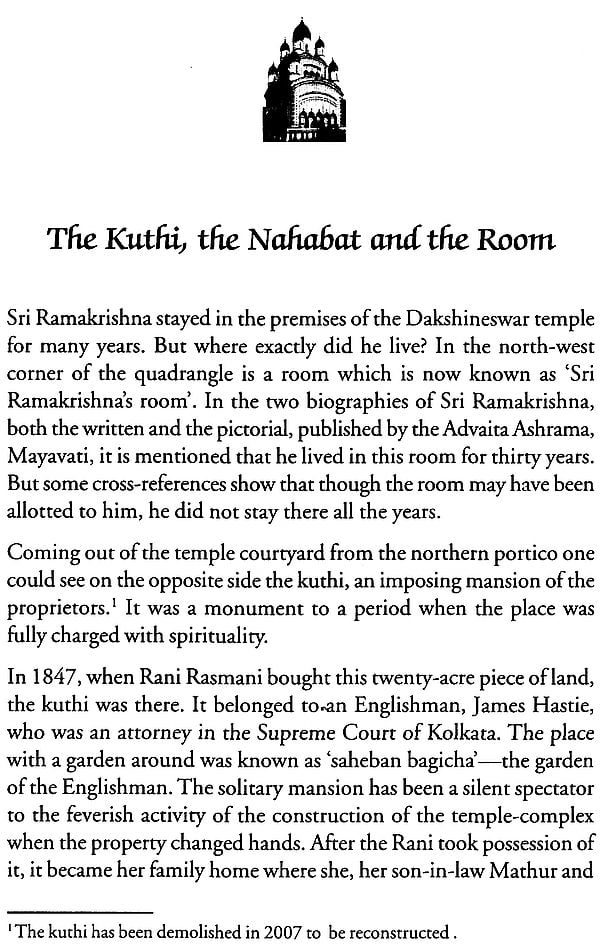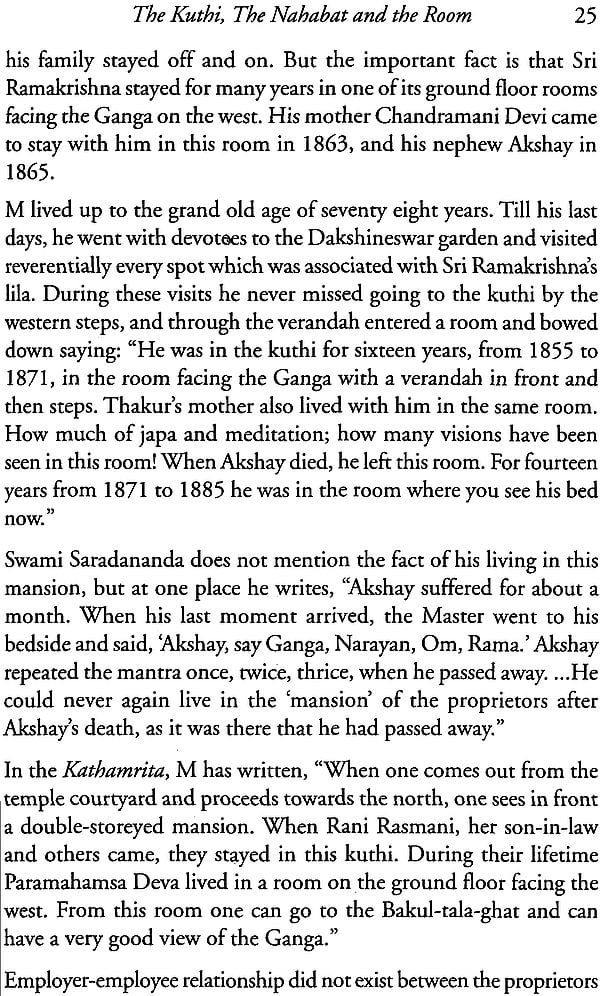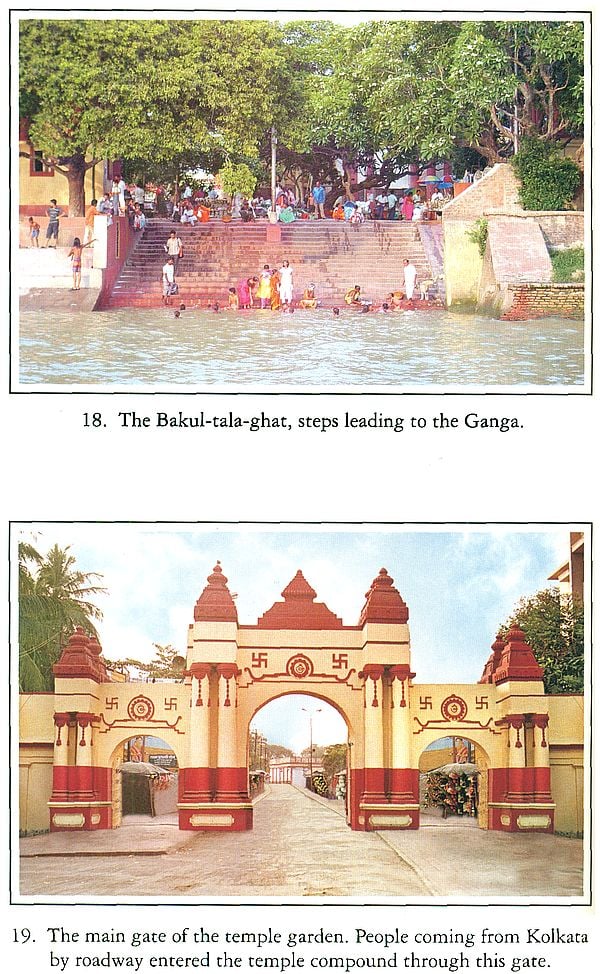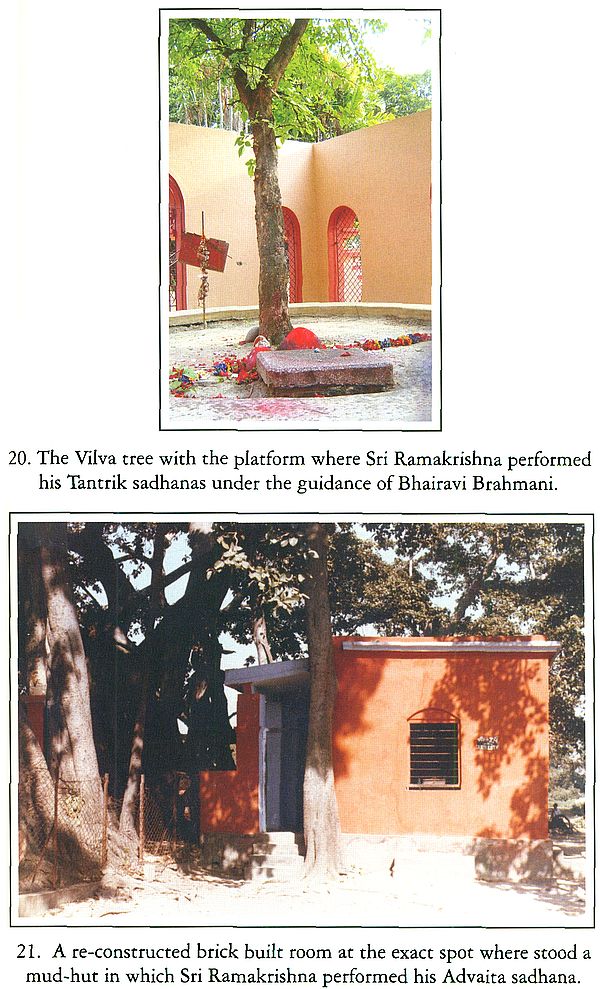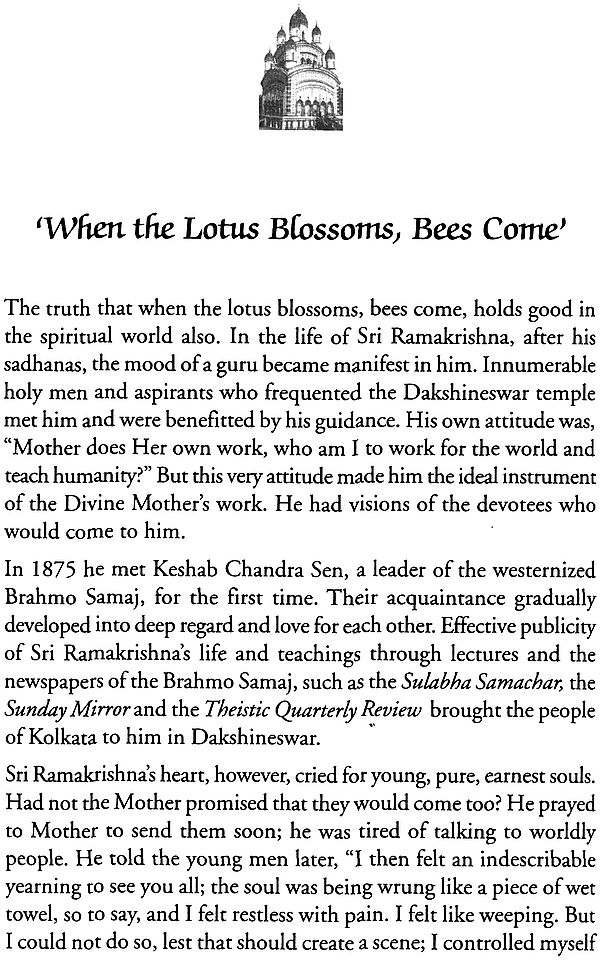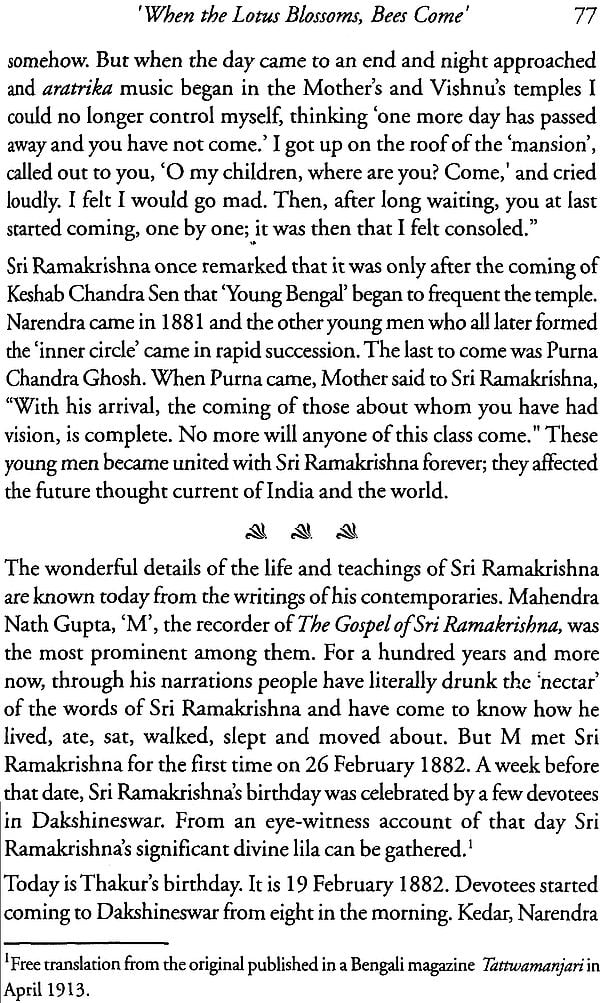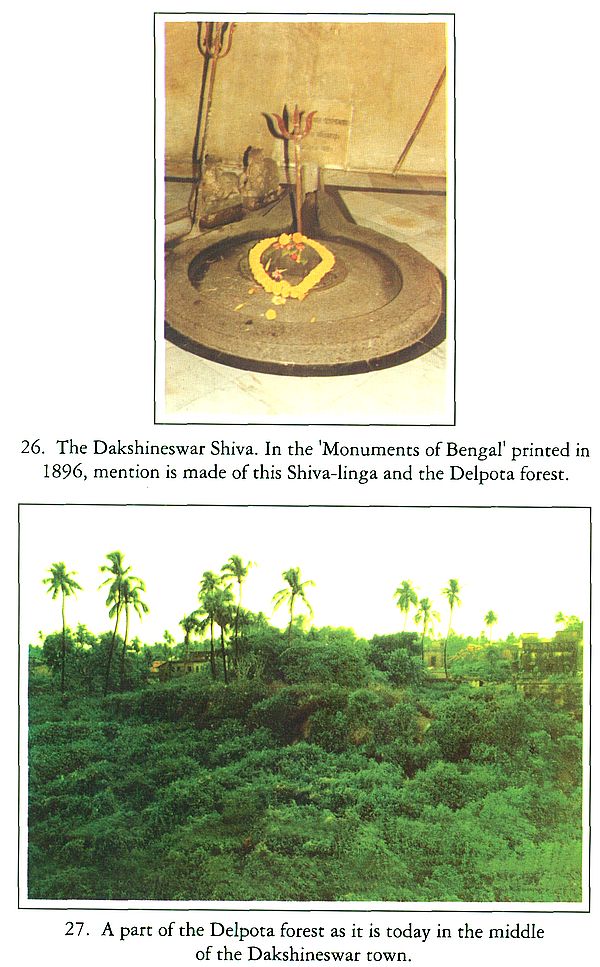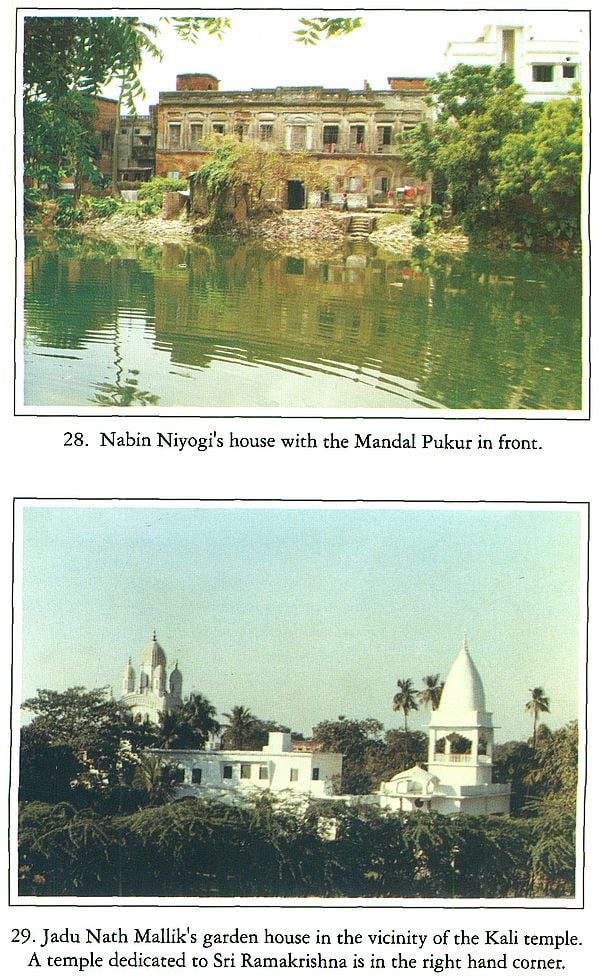
Sri Ramakrishna's Dakshineswar
Book Specification
| Item Code: | IDE649 |
| Author: | Ed. By. Pravrajika Atmaprana |
| Publisher: | Ramakrishna Sarada Mission |
| Language: | English |
| Edition: | 2012 |
| ISBN: | 8186617507 |
| Pages: | 89 (Color Illus: 31, B & W Illus: 2) |
| Cover: | Paperback |
| Other Details | 8.5" X 5.6" |
| Weight | 160 gm |
Book Description
When in March 1985, Sri Sarada Math, Dakshineswar, brought out a special issue of its journal Samvit on Dakshineswar, there was a popular demand for a more detailed book on this subject. We are thankful to Sri Sarada Math for giving to us the copyright of that special issue. It has enabled us to bring out this book entitled Sri Ramakrishna's Dakshineswar. Chapters 6, 7 and 9 have been reproduced in this book, as they appeared in the Samvit, because of their valuable contents. Some other writings from that issue have also been included in this book, though an overall change has been made in its presentation.
Devotees bear a deep and conscious love for their Ishta, the Chosen Ideal, and are content and happy thinking, talking and writing about their Ideal. Moreover, they love to identify themselves with his lila. As in the Bhagavata Purana, Nanda tells Uddhava, "My dear, when we remember Krishna and his playfulness, his loving glances, his smile and his words, all our interest in work slackens. Our minds get absorbed in Krishna when we see the places associated with him, the river, the hills, the forest and places of his sport, which are adorned with his footprints."
Devotees of Sri Ramakrishna, too, would love to follow his footprints as he lived in Dakshineswar for thirty years. Sri Ramakrishna is a vast book; Dakshineswar is only a chapter, but a very important one. So an attempt has been made in this book to capture the rarefied spiritual atmosphere of the Dakshineswar temple garden and its surrounding area as it was in his times. Like taking a dip in the cool waters of the Ganga, one can immerse oneself in his lila and remove the fatigue of gross worldly existence.
Before the ravages of time completely wipe off the landmarks in Dakshineswar and Ariadaha which are associated with Sri Ramakrishna, they are presented here in photographs.
The Foreword written by Her Holiness Pravrajika Mokshaprana Mataji, President of Sri Sarada Math and the Ramakrishna Sarada Mission, has come as a blessing to us.
We offer our special thanks to: Sri Tapan Ray Chaudhury of Calcutta, for the Cover and Plate Nos. 2 to 6, 9, 13, 14, 20, 27; Sri Kamala Kanta Chatterjee, Dakshineswar, for Plate No. 21; and Dr. Shelly Brown, M.D.,
New York, for the rest of the Plates, except Nos. 1, 12, 16, 32.
The compilation of Chapters 6, 7, 9 from different books and much other research work was done by Brahmacharini Sutapa of Sri Sarada Math, Indu Ramchandani took upon herself the entire responsibility of publishing the book and V. Bhaskaram prepared the typewritten copies of the manuscript. We express our gratitude to these three persons. It is due to their spirit of dedication and untiring zeal that the book has seen the light of day.
When a human society passes from one era to another, during the transitional stage, traditional dharma declines. An avatar then appears to revive the eternal values by instilling vigour into them by his superhuman endeavour. His aim is to make dharma dynamic and acceptable to the people of the new age. In India, an age of transition set in during the last two hundred years. The country lost its vitality, became weak and degenerate though it retained its latent wealth of spirituality. It was then divinely ordained that a new avatar be born in Bengal. The lila of God-in-human-form is best revealed in this age through Sri Ramakrishna.
Sri Ramakrishna often said, "Milk and its whiteness are invariably associated. It is impossible to think of the one without the other." In the same way, can one think of Sri Ramakrishna without Dakshineswar or Dakshineswar without Sri Ramakrishna? The importance, charm and fame of Dakshineswar revolve round the name of Sri Ramakrishna. Though the temples of Mother Kali, Sri Radhakanta and the twelve Shivas are still there, our fascination for them is rooted in the spiritually-charged atmosphere which still pervades the place due to Sri Ramakrishna's ecstatic experiences.
However we may express it-'Sri Ramakrishna of Dakshineswar' or 'Sri Ramakrishna's Dakshineswar'—the topic is equally interesting, ever sweet, ever full of the fervour of love. For, as he says, "Whichever way we may eat sweet bread, from the side or from the top, it will taste sweet."
The profundity of Sri Ramakrishna's thoughts and teachings is immeasurable and its influence is ever-widening. As a result, a plethora of books are being published, especially in the Bengali language, on him and Dakshineswar. This book, Sri Ramakrishna's Dakshineswar, published in this year of 1986, by the Delhi Centre of the Ramakrishna Sarada Mission, is a memorial edition. It has invaluable pictures and vivid descriptions of places and events connected with Sri Ramakrishna's life in Dakshineswar. It will be a source of information and inspiration to all his devotees and earnest seekers of spiritual values. This has made this book an exclusive venture in the existing literature on Sri Ramakrishna.
The Gospel of Sri Ramakrishna (originally written in Bengali and entitled Sri Sri Ramakrishna Kathamrita) is verily an 'ocean of nectar' which has in- fused life and hope into the hearts of an infinite number of people. Most of the incidents described in The Gospel took place in Dakshineswar.
This book describes how from his village Kamarpukur, circumstances brought him to Rani Rasmani's temple at Dakshineswar where he lived for thirty long years. Many ascetics, self-denying holy men and Paramahamsas went to the Kali temple in his days. All those who went there to practise sadhanas made quick spiritual progress in his company. To give an example, from Baranagore two youths came to him quite often as they had great love and reverence for him. "One day as he was sitting with them in the Panchavati, one of the boys experienced a certain spiritual state. His chest grew red; eyes deeper red; and streams of tears were rolling down; he could neither speak nor stand; he was just like one who had become drunk. Seeing his mood, Sri Ramakrishna was afraid and said to his Divine Mother, 'What have you done to him, Mother? People will say I have done some- thing and brought about that condition in him. He has his father and others, he will have to go home just now.' He passed his hand over the boy's chest while saying so to the Mother. The boy then became calm and went home a little afterwards."
Sri Ramakrishna used to say "God has the nature of a child." Through constant meditation on God Sri Ramakrishna's mind too had become simple like that of a child. If anyone said anything, he believed it to be entirely true. His relative Haldhari did not always believe in Sri Ramakrishna's high state of mind. He had a sharp tongue and spoke rudely to Sri Ramakrishna sometimes. One day he told Sri Ramakrishna that visions and the like, seen in ecstasy, were really untrue. Sri Ramakrishna believed his words and thought that all the divine forms he saw and words he heard in bhava- samadhi were a delusion. His Divine Mother had deceived him. Extremely anxious, he cried with the feeling of wounded love and said to the Mother, "Should you deceive me so, just because I am unlettered and ignorant?" His cry and agony would not stop, and, sitting in his room in the kuthi, he shed copious tears. He said later, "What I saw some time afterward was a fog-like mist rising suddenly from the floor and filling some of the space in front of me. Then I saw in that mist a beautiful living face of golden complexion, with beard reaching to the chest. The figure looked steadfastly at me and said in a deep voice, 'My Child, remain in bhava-mukha, the plane of divine relationships.' Repeating these words three times, the figure disappeared."
Sri Ramakrishna's devotion, trust and dependence on God were so intense that he commenced his sadhanas on the strength of these. His gurus and other holy men came later and guided him according to the shastras. After his experience of the Nirvikalpa Samadhi he felt that he need not retain his body, but his Divine Mother asked him to remain in bhava-mukha.
He knew then that he had a certain purpose in life, that is, the preservation and conservation of spiritual power and propagation of God's will, and therefore, he had to keep his physical body.
One day he asked the Holy Mother to clean his room and went to the Kali temple. The Holy Mother quickly started doing her work when Sri Ramakrishna returned from the temple reeling like an inebriated person. He pushed the Holy Mother like a drunkard and said indistinctly. "Am I a drunkard?" The Holy Mother replied, "No, no. Why should you be a drunkard?" Sri Ramakrishna asked, "Then why am I walking unsteadily? Why can't I speak?" The Holy Mother immediately said, "That is because you have drunk the nectar of Mother Kali's love." He happily made a rejoinder, "Yes, yes, you are right." The state of spiritual inebriation was frequent with him when he experienced a transcendental bliss which ordinary people could not comprehend.
At Dakshineswar, Sri Ramakrishna's sadhana was an all-inclusive endeavour for the emancipation of all beings-an emancipation which did not leave out even a single living creature, however lowly it may be. No person in the history of the world had made such an endeavour. He is the Dakshina-Iswar, the kind-hearted God.
| Foreword | v |
| Preface to the First Edition | ix |
| Preface to the Second Edition | xi |
| List of Illustration | xv |
| The Divine Will | 1 |
| Within the Holy Courtyard | 8 |
| The Kuthi, the Nahabat and the Room | 24 |
| The Divine Playground | 36 |
| Gurus in Succession | 46 |
| My Life in Dakshineswar | 59 |
| In Dakshineswar | 66 |
| 'When the Lotus Blooms Bees Come' | 76 |
| With Sri Ramalrishna in Dakshineswar | 80 |
| In and Around Dakshineswar | 86 |
| Bibliography | 98 |
| Glossary | 99 |
